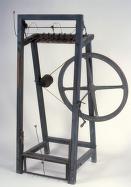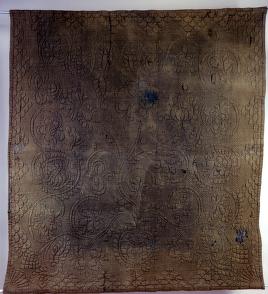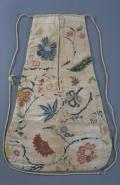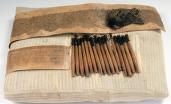Subcategory Women: Textile making contains 12 item(s).
 |
"Children at Play" Quilt
c. 1800
1983.12
This quilt depicting "Children at Play" illustrates how quilts served a decorative function as well as providing warmth in unheated bedchambers. |
 |
Spinning Jenny
c. 1800
1895.20
This is a rare, smaller domestic version of the water-powered spinning jenny, invented in England. |
 |
Flax Wheel
c. 1775
1914.07.28
Although some women used foot or flax wheels, transforming flax into linen was a laborious and complex process generally less common in America than spinning more easily processed sheep's wool into yarn. |
 |
Whole Cloth Quilt
c. 1798
BR.03
This "whole-cloth" 18th century quilt is made of three layers of wool; the top layer and bottom layer are of fabric and the middle, or filler layer, is fiber (often sheep's wool) all held together with running stitches in elaborate designs. |
 |
Embroidered pocket
1760-1780
1915.18.04
Throughout the 18th and early 19th centuries pockets were not attached to women's and girls' clothing. |
 |
Hand Stamp
c. 1775
1882.073.01
This carved wooden block would be used to print a design on cloth. |
 |
African-American woman sewing
1856-1858
1994.20.03.54
Like his other drawings of slave and southern plantation life, this interior sketch of slave quarters by George Fuller (1822-1884) of Deerfield, Massachusetts, carefully details the spaces in which slaves worked and lived. |
 |
Flail
1850-1900
1985.0011.01
A flail is used to separate, by hand, the seeds of grain (usually wheat) from the husks that protect them. |
 |
Lace Making Pillow
c. 1820
1881.028.01
|
 |
"Cloth from the Mill" advertisement
Sep 3, 1910
L02.160
This advertisement was run just as the woolen mills in Holyoke hit a high point in the years before World War I. |













